Nasa Astronomy Pictures, Good astronomy pictures from
Nasa
Welcome to this part of our astronomy website. Here
are some of our favorite Nasa Astronomy Pictures. Feel free to download any of these great
pictures of Nasa Astronomy to your computer for personal use. We are going to be adding
more Nasa astronomy pictures on this page soon. To view the Nasa Astronomy Pictures in
full size just click on the pictures.
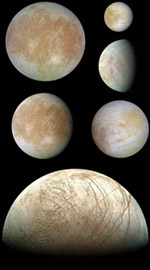
Although the phase of this moon might appear familiar, the moon itself might not. In fact,
this gibbous phase shows part of Jupiter's moon Europa. The robot spacecraft Galileo
captured this image mosaic during its mission orbiting Jupiter from 1995 - 2003. Visible
are plains of bright ice, cracks that run to the horizon, and dark patches that likely
contain both ice and dirt. Raised terrain is particularly apparent near the terminator,
where it casts shadows. Europa is nearly the same size as Earth's Moon, but much smoother,
showing few highlands or large impact craters. Evidence and images from the Galileo
spacecraft, indicated that liquid oceans might exist below the icy surface. |
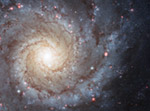 If not perfect, then this spiral galaxy
is at least one of the most photogenic. An island universe of about 100 billion stars, 32
million light-years away toward the constellation Pisces, M74 presents a gorgeous face-on
view. Classified as an Sc galaxy, the grand design of M74's graceful spiral arms are
traced by bright blue star clusters and dark cosmic dust lanes. |

This cosmic expanse of dust, gas, and stars covers
some 4 degrees on the sky in the heroic constellation Perseus. Centered in the gorgeous
skyscape is the dusty blue reflection nebula NGC 1333, about 1,000 light-years away. At
that estimated distance, the field of view is nearly 70 light-years across. Other
reflection nebulae are scattered around, along with remarkable dark dust nebulae and the
faint reddish glow of hydrogen gas. These dust and gas clouds lie near the edge of a large
molecular cloud. |
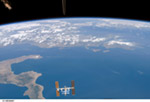 Last August, the Space Shuttle Endeavour
crew captured this shot of the International Space Station (ISS) against the backdrop of
Planet Earth. During that trip to the ISS, the space shuttle crew re-supplied the station,
repaired the station, and even built more of the station. Its primary mission complete,
the crew took the premier spaceship on a tour around the premier space station. Pictured
during this inspection tour, the ISS is visible in front the Ionian Sea. The boot of Italy
is visible on the left, while the western coastlines of Greece and Albania stretch across
the top. |
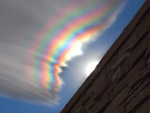 Why would a cloud appear to be different
colors? A relatively rare phenomenon known as iridescent clouds can show unusual colors
vividly or a whole spectrum of colors simultaneously. These clouds are formed of small
water droplets of nearly uniform size. When the Sun is in the right position and mostly
hidden by thick clouds, these thinner clouds significantly diffract sunlight in a nearly
coherent manner, with different colors being deflected by different amounts. |
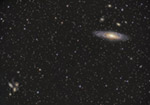 This wide, sharp telescopic view reveals
galaxies scattered beyond the stars near the northern boundary of the high-flying
constellation Pegasus. Prominent at the upper right is NGC 7331. A mere 50 million
light-years away, the large spiral is one of the brighter galaxies not included in Charles
Messier's famous 18th century catalog. The disturbed looking group of galaxies at the
lower left is well-known as Stephan's Quintet. |
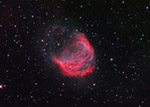 Braided, serpentine filaments of glowing
gas suggest this nebula's popular name, The Medusa Nebula. Also known as Abell 21, this
Medusa is an old planetary nebula some 1,500 light-years away in the constellation Gemini.
Like its mythological namesake, the nebula is associated with a dramatic transformation.
The planetary nebula phase represents a final stage in the evolution of low mass stars
like the sun, as they transform themselves from red giants to hot white dwarf stars and in
the process shrug off their outer layers. |
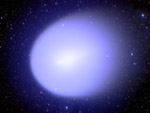 The spherical coma of Comet Holmes has
swollen to a diameter of over 1.4 million kilometers, making the tenuous, dusty cloud even
bigger than the Sun. Scattering sunlight, all that dust and gas came from the comet's
remarkably active nucleus, whose diameter before the late October outburst was estimated
to be a mere 3.4 kilometers. In this sharp image, recorded on November 14 with the
Canada-France-Hawaii Telescope, stars are easily visible right through the outer coma,
while the nucleus is buried inside the condensed, bright region. |
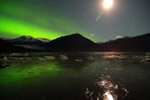 Some auroras can only be seen with a
camera. They are called sub-visual and are too faint to be seen with the unaided eye. The
reason is that the human eye only accumulates light for a fraction of a second at a time,
while a camera shutter can be left open indefinitely. When photographing an already
picturesque scene above Juneau, Alaska, USA, a camera caught green sub-visual aurora near
the horizon. Auroras are sparked by energetic particles from the Sun impacting the
magnetic environment around the Earth. Resultant energetic particles such as electrons and
protons rain down near the Earth's poles and impact the air. |
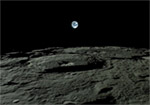 What does the Earth look like from the
Moon? A new version of this space age perspective was captured by the robotic Kaguya
spacecraft currently in orbit around Earth's Moon. Launched two months ago by Japan, the
scientific mission of the Selenological and Engineering Explorer (SELENE), nicknamed
Kaguya, is to study the origin and evolution of the Moon. Last month Kaguya reached lunar
orbit and starting transmitting data and images. This frame is from Kaguya's onboard HDTV
camera. |
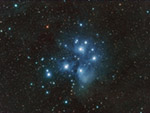 Perhaps the most famous star cluster on
the sky, the Pleiades can be seen without binoculars from even the depths of a
light-polluted city. Also known as the Seven Sisters and M45, the Pleiades is one of the
brightest and closest open clusters. The Pleiades contains over 3000 stars, is about 400
light years away, and only 13 light years across. Quite evident in the above photograph
are the blue reflection nebulae that surround the brighter cluster stars. Low mass, faint,
brown dwarfs have also been found in the Pleiades. |
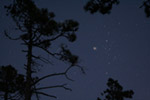 With pine trees in dim silhouette, this
skyscape from Breil-sur-Roya in southern France was captured on November 11. In the early
evening scene, a satellite seems to streak through the branches, while bright, round,
fuzzy Comet Holmes appears to lie just beyond them, near the stars of the constellation
Perseus. Mirfak, alpha star of Perseus, is the brightest star above the comet and to the
right. Next Monday (November 19), Holmes will be close enough to Mirfak to view the star
through the remarkable comet's expanding coma. Recent measurements place the dusty coma's
diameter at about 1.4 million kilometers, even larger than the Sun. |
|
|